#proxima b
Explore tagged Tumblr posts
Text
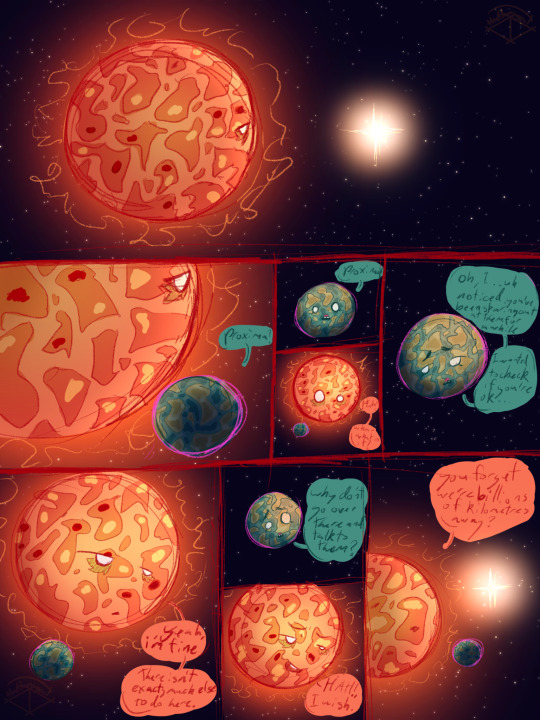
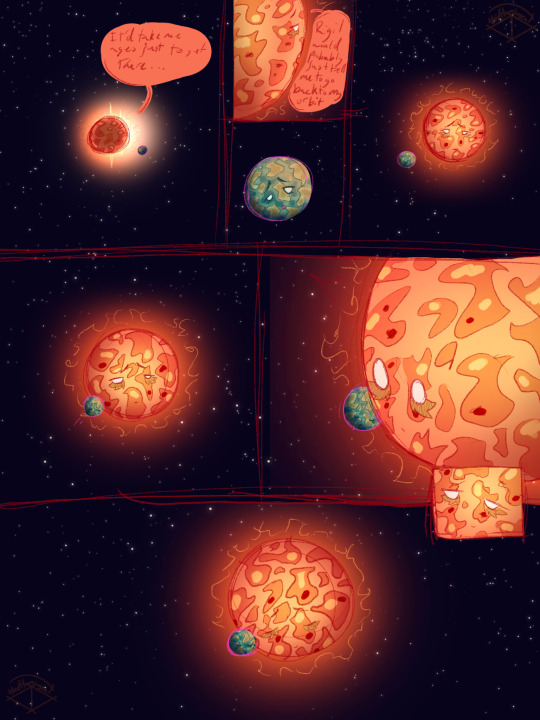
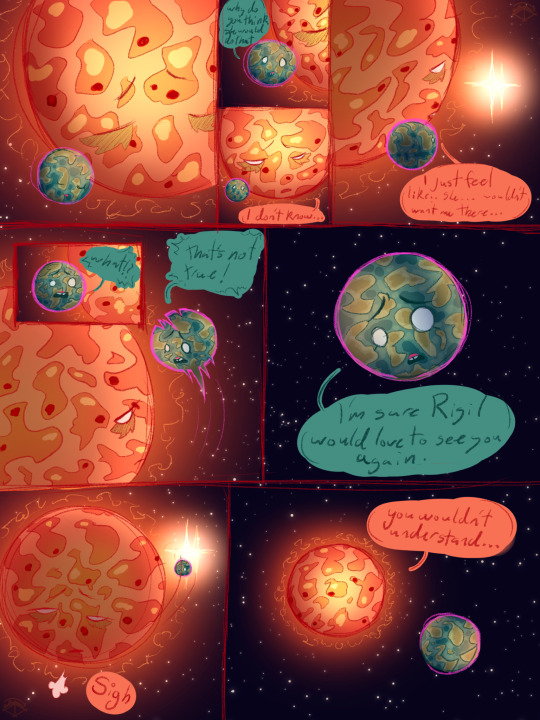
A little Proxima and Ataraxia (Proxima b) comic
#artists on tumblr#digital art#digital artist#original characters#solarballs#solarballs fanart#alpha centauri#proxima centauri#proxima b#fanart
72 notes
·
View notes
Text




#exoplanet#exoplanets#proxima b#alien life#astronomy#astronomers#nasa#universe#nasa photos#astrophotography#astrophysics#outer space#nasawebb#hubble space telescope#space exploration#space#science#space shuttle#our universe#the universe#planetary science#science facts#nasa science#space science#planetary nebula#cosmos#nasaastronaut#nasa jpl#nasa picture of the day#i love astronomy
45 notes
·
View notes
Text
Views from Alpha Centauri
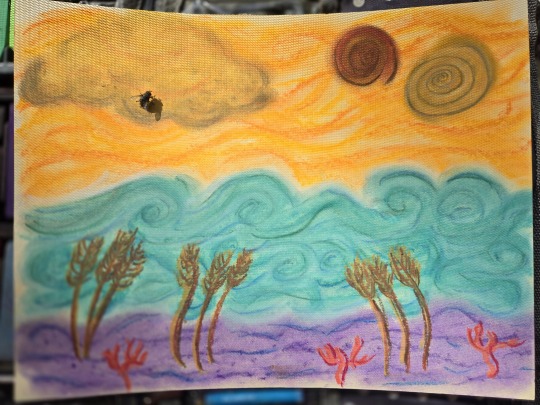
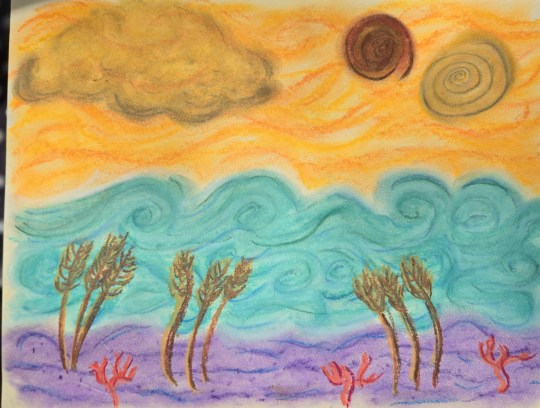

Had some fun playing with colorful chalk pastels.
A double sunset as seen from Proxima B maybe?
Lord Beelzebub was kind enough to ✨️fly ✨️ in for a visit 😅
#chalk pastel#i drew something#Proxima B#good omens fanart#good omens beelzebub#off topic#sort of#alpha centauri
9 notes
·
View notes
Text
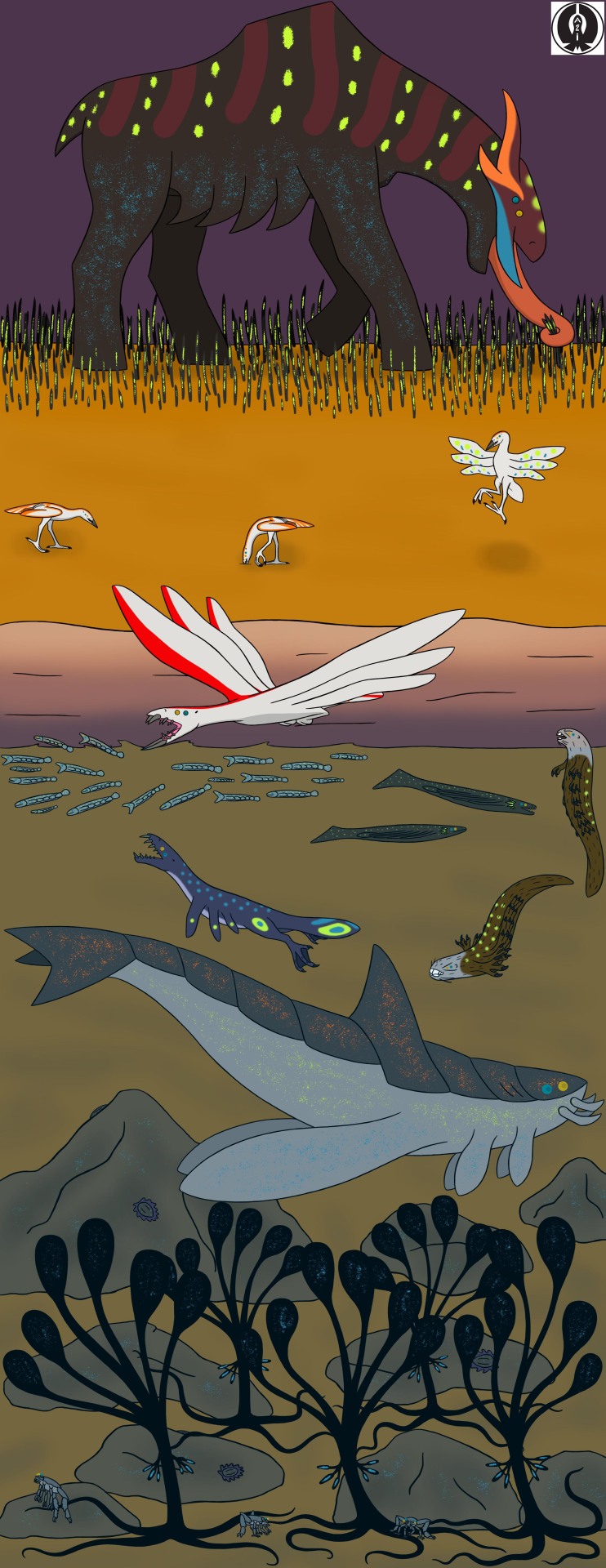
This was much delayed due to me coming down with Covid. Fortunately I recovered and was able to finish this. This is another land/seascape of Proxima B (a real planet that I'm speculating life on). This features some of the lifeforms that inhabit the coastlines in and out of the water. I've included some organisms that I've depicted in previous pieces but with a clearer view of them. Here's a quick rundown of them.
Lesser Razorback: a medium sized herbivore that favor running blades (the grass-like organisms around it) that grow along the shores.
Sandpiker Wyvern: small wyverns that probe the sand for organisms that burrow in it.
Skimmer Wyvern: Wyverns that soar just above the water to skim for prey using their specialized teeth.
Shoaling fishamander: Small filter feeding fishamanders that form large shoals as anchovies and sardines do on Earth.
Seadics: small predators that can glide temporarily using disc shaped membranes.
Sea Pooka: An otter-like Pooka that dives for shelled invertebrates.
Sea Wyvern: A flightless wyvern species with a lifestyle akin to penguins and auks.
Lesser Seaspinner: A smaller Seaspinner species that inhabits shallow waters along the coasts.
Kelp Seafan: A marine species of fan that is much darker than their terrestrial counterparts to better photosynthesize
Sea scale: mollusk like invertebrates that feed on bacteria that grow on rocks and other surfaces.
Reef Hopper: crab-like relatives of the more insect-like springers that feed on kelp fans and carcasses that fall to the bottom.
I might make a page devoted to fishamander species as there would be much many more than what I've shown.
As always, comments and critiques are welcome.
#alien planet#alien#aliens#extraterrestrials#extraterrestrial#astrobiology#speculative biology#creature design#seascape#landscape#proxima b#my art#digital art#digital color#digital illustration#ecology#shoreline#coastline#coast#sea#animals#predator#prey#alien life#extraterrestial life#science fiction#scifi#fish#wyvern
26 notes
·
View notes
Text

It's so exciting that @nasa found evidence of life on #ProximaB thanks to the James Webb Telescope!
#NASA #JamesWebbTelescope #DollarGeneral
#NASA#Proxima B#James Webb#James Webb Telescope#Astronomy#Lights#Dollar General#Telescope#Aliens#UFO#UAP
4 notes
·
View notes
Text
EP. 13: FIVE REALISTIC WAYS TO REACH THE STARS.
In the future, humans will explore the stars. This may happen in a few decades or centuries, but it is inevitable. The long time period is due to the fact that stars are incredibly distant, beyond what we can imagine. Our current technology is not advanced enough to travel through interstellar space. However, as we advance in our understanding of physics and technology, it is likely that we will…
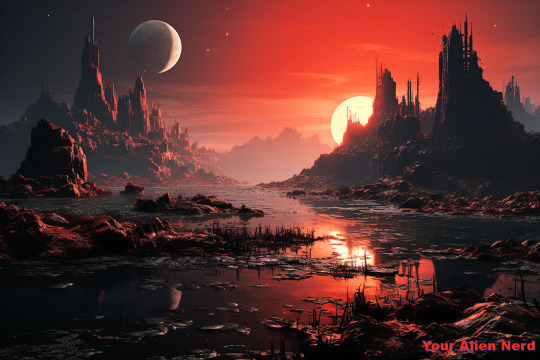
View On WordPress
#anti-matter propulsion#generation ship#interstellar travel#ion propulsion#Proxima b#Proxima Centauri#Proxima Centauri b#solar sail#warp bubble#warp drive#wormoholes
2 notes
·
View notes
Text
youtube
#brainykidz#educational#quizzes#trivia#youtube#solar system#planet venus#quiz time#venus#universe#proxima centauri#proxima b
0 notes
Text
Alpha Centauri could now potentially be within human reach, 43 year journey not a bad start!
youtube
#alphacentauri#alpha centauri#avatar#avatar2#james cameron#jamescameron#pandora#navi#thewayofthewater#worldspirit#proxima centauri#proxima b#proxima#Youtube
0 notes
Text
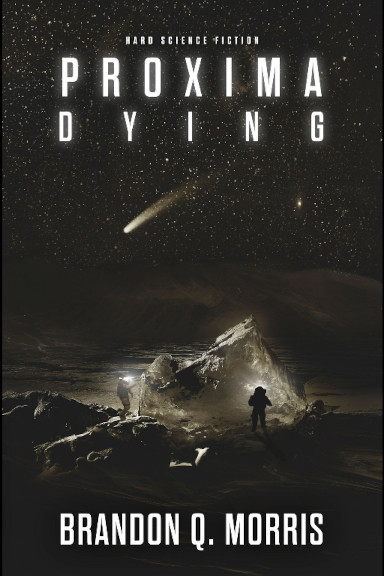
The novel "Proxima Dying" by Brandon Q. Morris was published for the first time in 2021. It's the second book in the Proxima Trilogy and follows "Proxima Rising". The English translation is by Frank Dietz.
Marchenko is using a robotic body to host him to be able to accompany Adam and Eve in their exploration of the planet Proxima b in search of the natives who sent a signal into space. It's certainly not an easy mission, especially after what they discovered.
On the planet's day side, the one always illuminated by its star, there seems to be no trace of sentient inhabitants. The travelers decide to move the search to the night side with the difficulties that this brings, starting with the perpetual darkness and the ice that covers that hemisphere.
0 notes
Text
Interesting! Proxima Centauri, like many red dwarf stars, is probably a flare star. This would likely make the surface of Proxima b uninhabitable, and might even destroy any atmosphere it originally had. However, if there were a subsurface ocean, it would be protected from Proxima’s radiation, and could possibly be habitable.

Habitability of nearby Earth-sized Exoplanets
When it comes to planets, our Solar system is not alone, and more recently our ability to confirm and spot smaller rocky planets has been adding to our understanding of how planets are formed and that our Solar System far from being a model to use elsewhere, is rather unique.

Still, moons like Europa may offer a model by which we can judge water on those Earth sized planets that happen to be within the habitable zone (or slightly either side of it) and how interactions with their stars and environment could look.
Proxima b is one particular exo-planet of interest, orbiting it's host star Proxima Centauri every 11 days, but with Proxima being a very small red dwarf, that put's the planet within the area we'd expect to see liquid water.

A recent study of a number of similar exoplanets including Proxima b, and comparing them to Europa, has shown that the planets are likely much colder than first assumed, but also covered in ice with subsurface oceans. Proxima b in particular is calculated to have the thinnest ice sheet with an average of just 58m, and with the tidal forces from Proxima heating up the interior, it's expected the planet will have thousands of time more water upwelling and guizers constantly delivering liquid water to the surface.
While this is all theoretical, we are now able to test the hypothesis, as Proxima b passes it's star so frequently, sufficient observations of the planet's transit could yield water vapour at varying levels. Expect JWST to be watching in the near future !
Source :
44 notes
·
View notes
Text
Cybertron's Location
Okay so Alpha Centauri is named as Cybertron's star system in multiple continuities.
Easy, right? Just make up a planet for Cybertron to be. Plausible enough that there's one out there we don't know about.
NOPE. I found a spot for it.
The Alpha Centauri system has three stars in it. These are Rigil Kentaurus (α Centauri A), Toliman (α Centauri B), and Proxima Centauri (α Centauri C). I'm going to be calling them by their non-ABC names for distinction.
Alpha Centauri, as we see it, is Rigil Kentaurus and Toliman's lights being indistinguishable from one another. Those two are a binary star system of sun-like stars, so their orbit intersects and they look something like this:

Meanwhile, Proxima Centauri is a red dwarf, and orbits at a pretty far distance, like so:

It's still part of the same star system because it still orbits around a common point, but in any planet that orbits Proxima, Rigil and Toliman just look like exceptionally bright stars in its sky.
So the question THEN is, which star does Cybertron orbit?
Proxima's the most obvious candidate. It even has a full planetary system:
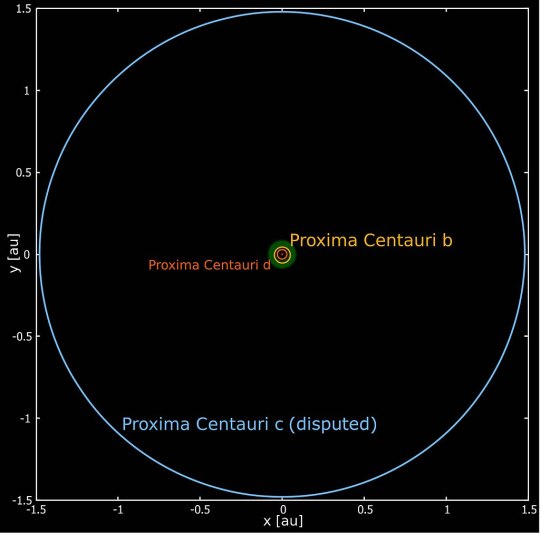
Proxima Centauri b is in Proxima's habitable zone (the area where water could feasibly exist as liquid), and it's just a little bigger than Earth.
Generally speaking, Cybertron is depicted as larger than Earth, so let's set that aside for this post.
Proxima Centauri d is a tiny planet that's closer to Proxima and no smaller than a third Earth's size.
Proxima Centauri c is either a super-Earth or a gas dwarf, about 7 times Earth's mass, which is disputed both in its nature and whether or not it's really a planet (it's complicated). Regardless, it's outside the habitable zone.
So it could be Proxima c. That's our default option. The biggest problem is the lack of a habitable zone, because, while giant robots don't necessarily need comfortable heat to live, there's the whole "acid rain" and "sea of rust" deal that'd be hard in a planet that far from its sun.
Granted, sometimes Cybertron is seen hurtling through space without a sun or any of those features to speak of, but I'd like to account for it.
So what about the other two?
Toliman was claimed to have a planet orbiting it in 2012 (α Centauri Bb), but by 2016, it was more or less conceded that said planet didn't exist.
Rigil Kentaurus, on the other hand...
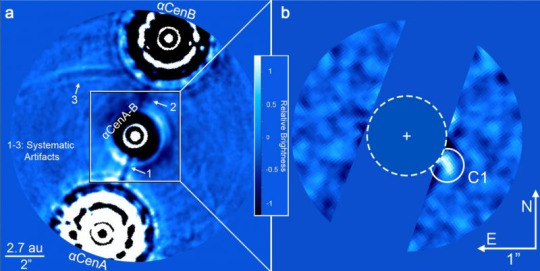
Meet Candidate 1 (α Centauri Ab).
It orbits within Rigil's habitable zone, has a period of about a year, and has a mass between Neptune and half of Saturn, with possible habitable moons.
Does it exist? Maybe.
The thing is about Candidate 1 (yes that is its real name) is that it wasn't observed for long enough to confirm its existence. It COULD be a planet. It could also be dust that got captured, or an artifact of the observational instruments.
THIS is my proposal for Cybertron.
TLDR: There's a (possible) planet that orbits the brightest star of the Alpha Centauri star system in its habitable zone and it's bigger than Earth.
#long post#transformers#maccadam#worldbuilding#theory#cybertron#this is definitely 100% cybertron in MoL#but i feel like it could work for multiple continuities#TFP is tricky given the whole Unicron-is-Earth thing. that one would more likely be proxima b#just for size consistency between unicron and primus#and it doesn't work for the bayverse cybertron because that's saturn-sized#but look. neptune is 4x as big as earth#this is possibly a bit bigger than that#the dimensions for candidate 1 are between 3.3 and 7 earth radii#and the average size of a cybertronian (excluding things like minibots/minicons) is between 3.3 and 7 humans tall#anyways i really hope i did the image id on that last picture right. that thing is HARD to understand#real coffee hours
241 notes
·
View notes
Text
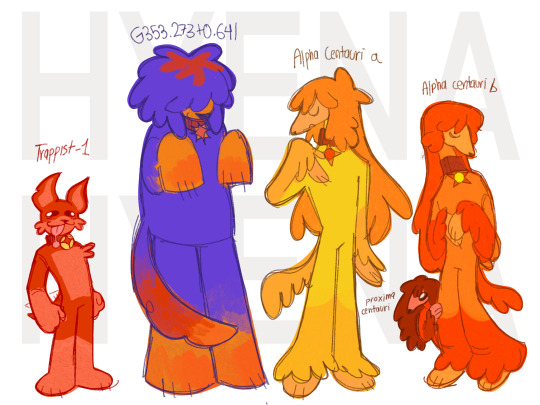
DOGDAYS FANMADE FAMILY BASED ON REAL STARS BECAUSE STARS ARE SO COOL AND I LOVE THEM SO MUCH
#poppy playtime#poppy playtime 3#art#fanart#dogday#trappist-1#g353.273+0641#(a baby star!!!)#alpha centauri a#alpha centauri b#proxima centauri#i love stars so much oh my gosh someone help me
289 notes
·
View notes
Text
Alpha Centauri Characters










#Neptune Adventure#Alpha Centauri#Rigil Kentaurus#Toliman#Proxima Centauri#Xandian#Broccolo#Ursula#Linda#Quellus#Kine#Art#New Art#Rigil Kentaurus b#Toliman b#Toliman c#Proxima Centauri b#Proxima Centauri c#Proxima Centauri d
10 notes
·
View notes
Text
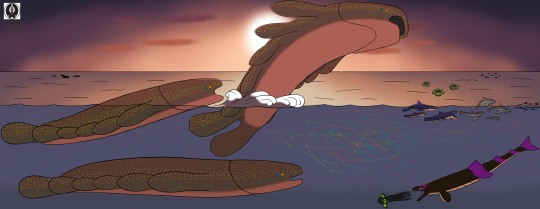
This is another blast from the past; a seascape piece featuring a hypothetical environment from the real world planet Proxima B. This depicts some of the ocean life for this world, two of which I gave glimpses of in my last piece dedicated to Proxima B. I'll try to give a quick rundown of the lifeforms shown here (I make a lot of references to much older posts related to Proxima B).
Titan Fishamander: Growing up to 84m long, the Titan Fishamader is the largest organism on Proxima b. They feed on anything that enter their gaping mouths though its mostly consists of smaller marine organisms (indicated by the swirling colors in the water).
Killer Fishamander: They are Proxima B's equivalent to orca's in behavior and size (slightly over 10M). Killer Fishamanders travel in small pods that pursue prey in the water and on the shores which they can pursue thanks to their powerful lobbed fins.
Seaspinner: Dolphin-like relatives of the smaller, insect-like Springers, Seaspinners travel along the shores in large pods hunting smaller organisms.
Seadiscs: Seadiscs are an equivalent to flying fish from earth accept with more circular fins and descended from terrestrial ancestors. They are among the smallest members of a family of carnivores that incudes Drakes, Cockatrices, and the sapient Proxima Centaurians.
Kraken Seafans: Hailing from a family of photosynthesis plantanimals, Kraken Seafans are the most mobile of their group and even occasionally hunt smaller prey for extra nutrients along with photosynthesizing.
Leviathan: The Leviathans are solitary ambush hunters who are they apex predators of Proxima B's oceans. At over 40m in length, they are the largest members of their family, even out sizing their terrestrial counterparts the Kur whom are their closest living relatives.
I really did miss doing these creatures and may even do a smaller piece depicting smaller oceanic/shoreline organisms of Proxima B.
As always, comments and critiques are welcome.
#alien planet#alien#aliens#alien life#extraterrestrial#extraterrestrials#extraterrestial life#seascape#ocean#sunset#proxima centauri#proxima centauri b#proxima b#creature design#astrobiology#speculative biology#ecology#xenology#predators#prey#my art#digital art#digital color#digital illustration#animals#red dwarf#kraken#leviathan#sea#marine life
9 notes
·
View notes
Text

now kiss
#getting ready for bed on proxima b <3#ineffable beurocracy#beelzebub good omens#gabriel good omens#good omens#I hope no one expects me to care about things like perspective or anatomy#or how to consistently draw hands#go2#art tag
50 notes
·
View notes
Text
Proxima Centauri B
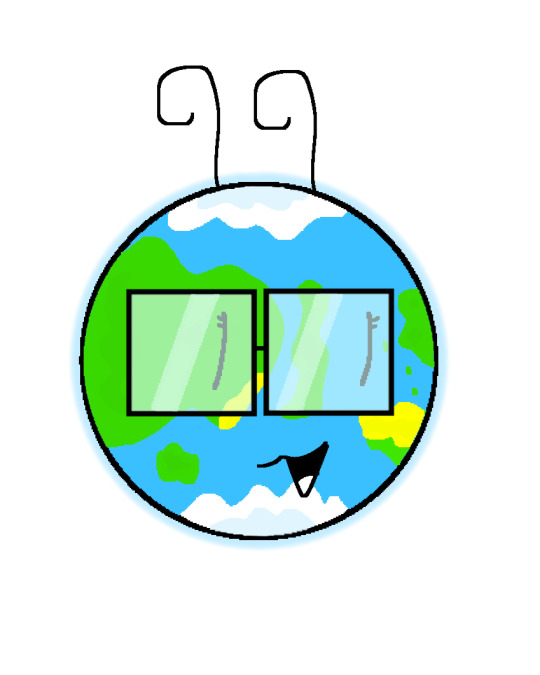
I really need to draw more about this planetary system
8 notes
·
View notes